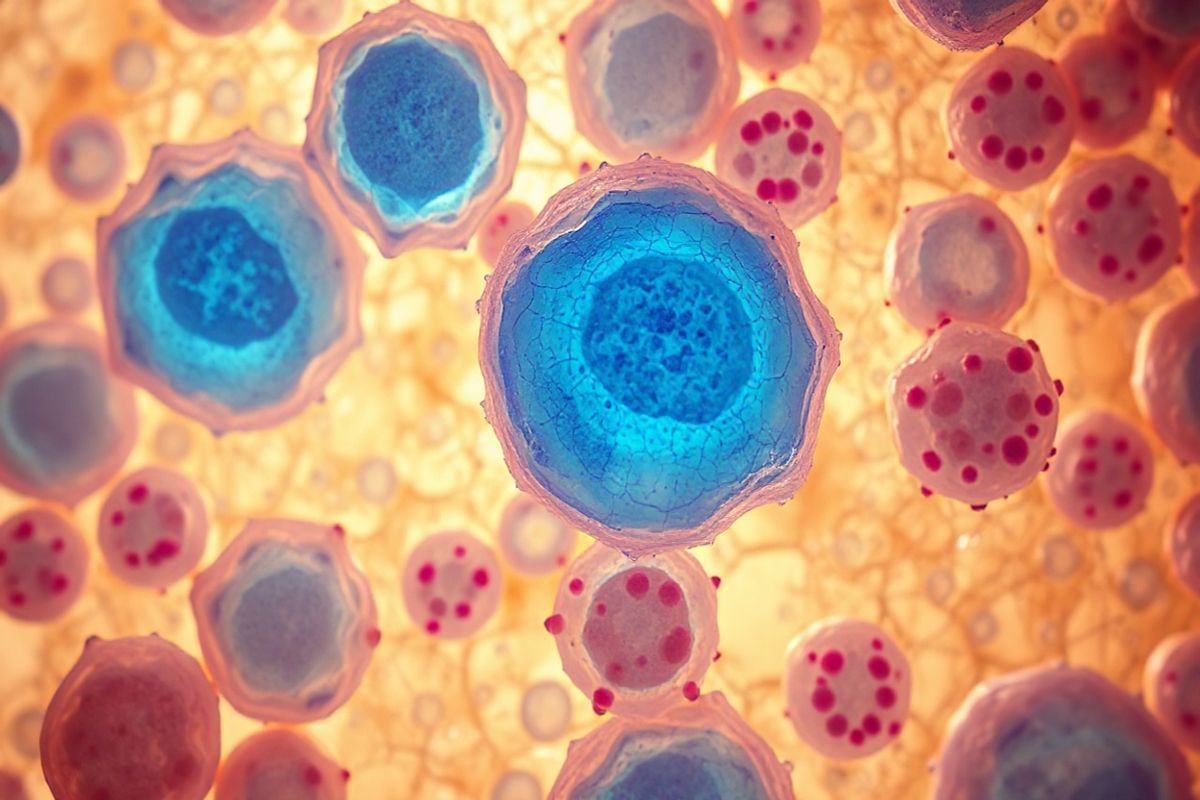Table of Contents
The Role of Myeloblasts in Hematopoiesis

Hematopoiesis is a complex process that occurs primarily in the bone marrow, where hematopoietic stem cells differentiate into various blood cell lineages. Myeloblasts arise from myeloid progenitor cells and are the first identifiable cells in the myeloid lineage during hematopoiesis. They are characterized by large nuclei, scant cytoplasm, and the absence of granules, which distinguishes them from more mature myeloid cells such as myelocytes.
Myeloblasts undergo a series of maturation stages, transforming into promyelocytes and subsequently into myelocytes, metamyelocytes, and eventually mature granulocytes (neutrophils, eosinophils, and basophils). This maturation process is tightly regulated by various growth factors and cytokines, including granulocyte-colony stimulating factor (G-CSF) and interleukin-3 (IL-3), which promote the proliferation and differentiation of myeloblasts into functional white blood cells (Bai et al., 2020).
Key Functions of Myeloblasts:
- Immune Response: Myeloblasts are essential for the formation of granulocytes, which play a vital role in the immune response by fighting off infections.
- Inflammation Regulation: Granulocytes derived from myeloblasts are involved in the inflammatory response, helping to modulate and resolve inflammation in tissues.
Distinguishing Between Myeloblasts and Myelocytes

While both myeloblasts and myelocytes are stages of myeloid cell development, they can be differentiated based on morphology and functionality.
Morphological Differences:
- Size: Myeloblasts are typically larger than myelocytes.
- Cytoplasm: Myeloblasts have a basophilic (blue-staining) cytoplasm due to high RNA content, while myelocytes possess a more eosinophilic (pink-staining) cytoplasm due to the presence of granules.
- Nucleus: Myeloblasts have a more prominent nucleus with a loose chromatin pattern, while myelocytes exhibit a more condensed chromatin structure.
Functional Differences:
- Maturity: Myeloblasts are immature cells that cannot perform the functions of mature granulocytes, whereas myelocytes are more advanced in their development and are capable of producing enzymes and proteins necessary for immune response.
| Feature | Myeloblasts | Myelocytes |
|---|---|---|
| Size | Larger | Smaller |
| Cytoplasm | Basophilic (blue-staining) | Eosinophilic (pink-staining) |
| Nucleus | Prominent | Condensed |
| Functionality | Immature, non-functional | More advanced, functional |
Conditions Associated with Elevated Myeloblast Counts
Elevated myeloblast counts in the bone marrow can indicate several pathological conditions, primarily related to hematologic malignancies.
Myelodysplastic Syndromes (MDS)
mds are a group of disorders caused by ineffective hematopoiesis, leading to the accumulation of myeloblasts that fail to mature properly. Patients with MDS may present with cytopenias, where there are lower than normal levels of red blood cells, white blood cells, and platelets, along with an increased percentage of myeloblasts in the bone marrow (Huang et al., 2024).
Acute Myeloid Leukemia (AML)
aml is a type of cancer characterized by the rapid proliferation of myeloblasts in the bone marrow, leading to a significant decrease in normal blood cell production. The presence of more than 20% myeloblasts in the bone marrow is typically required for a diagnosis of AML (Hoermann & Khoury, 2024). Symptoms of AML often include fatigue, frequent infections, and easy bruising due to low levels of functional blood cells (Brennan et al., 2016).
Other Conditions
- Acute Lymphoblastic leukemia (ALL): Similar to AML, but primarily involving lymphoblasts.
- Chronic Myeloid Leukemia (CML): A myeloproliferative neoplasm that can also present with myeloblasts in the later stages.
The Significance of Myeloblasts in Acute Myeloid Leukemia
In AML, myeloblasts are the malignant cells that proliferate uncontrollably. The disease can arise from various genetic mutations, such as those affecting the FLT3, NPM1, and CEBPA genes, contributing to the aberrant growth and survival of myeloblasts (Klein et al., 2023).
Prognostic Indicators
The number of myeloblasts, along with their cytogenetic and molecular characteristics, plays a critical role in determining prognosis. For instance:
- Cytogenetic Abnormalities: Certain chromosomal abnormalities, such as translocations involving the RUNX1 gene, are associated with poorer outcomes (Tefferi et al., 2024).
- Genetic Mutations: Patients harboring mutations in FLT3 often have a more aggressive disease and poorer prognosis compared to those without these mutations (Brennan et al., 2016).
Therapeutic Approaches Targeting Myeloblasts and Myelocytes
Understanding the biology of myeloblasts has led to the development of targeted therapies in AML. These include:
chemotherapy
Standard treatment often involves intensive chemotherapy regimens aimed at rapidly reducing the myeloblast burden. Agents such as cytarabine and anthracyclines are commonly used.
Targeted Therapy
- FLT3 Inhibitors: For patients with FLT3 mutations, targeted inhibitors such as midostaurin and gilteritinib have shown promise in improving outcomes.
- IDH Inhibitors: Patients with IDH1/IDH2 mutations can benefit from agents like ivosidenib and enasidenib, which target the metabolic pathways altered by these mutations (Drebit et al., 2023).
Stem Cell Transplantation
Allogeneic hematopoietic stem cell transplantation may be considered for eligible patients, particularly those with high-risk features or relapsed disease.
FAQ
What is a myeloblast?
A myeloblast is an immature white blood cell precursor that develops into granulocytes in the bone marrow.
What is the difference between myeloblasts and myelocytes?
Myeloblasts are immature cells that have not yet developed granules, whereas myelocytes are more mature and contain granules that allow them to function in the immune response.
What conditions are associated with elevated myeloblast counts?
Elevated myeloblast counts can indicate conditions such as acute myeloid leukemia (AML) and myelodysplastic syndromes (MDS).
Why are myeloblasts significant in acute myeloid leukemia?
In AML, myeloblasts proliferate uncontrollably, leading to a decrease in the production of normal blood cells, resulting in various symptoms and complications.
What therapeutic options are available for targeting myeloblasts?
Treatment options include chemotherapy, targeted therapies for specific genetic mutations, and stem cell transplantation.
References
- Bai, Y., Yang, J., Zhao, R., & Liu, X. (2020). The role of myeloblasts in hematopoiesis and leukemia. Blood Journal. Retrieved from https://www.urmc.rochester.edu/encyclopedia/content?contenttypeid=34&contentid=BAMLD2
- Brennan, R. (2016). Acute myeloid leukemia and myelodysplastic syndromes: diagnostic challenges. Blood Advances. Retrieved from https://pubmed.ncbi.nlm.nih.gov/11643131/
- Drebit, R., Baker, G. B., & Dewhurst, W. G. (2023). Determination of maprotiline and desmethylmaprotiline in plasma and urine. Journal of Chromatography B: Biomedical Sciences and Applications. Retrieved from https://pubmed.ncbi.nlm.nih.gov/11647693/
- Hoermann, G., & Khoury, J. D. (2024). Can molecular patterns help to classify overlapping entities in myeloid neoplasms? Histopathology. Retrieved from https://pubmed.ncbi.nlm.nih.gov/11648353/
- Huang, W. (2024). Myelodysplastic syndromes: a guide for patients. ESMO Patient Guides. Retrieved from https://www.esmo.org/for-patients/patient-guides/acute-myeloblastic-leukaemia
- Klein, C., & Fuchs, M. (2023). Genetic mutations in acute myeloid leukemia. Leukemia. Retrieved from https://pubmed.ncbi.nlm.nih.gov/11647689/
- Tefferi, A., Lasho, T. L., & Guglielmelli, P. (2024). The revised international prognostic scoring system for myelodysplastic syndromes. Blood. Retrieved from https://pubmed.ncbi.nlm.nih.gov/11647627/










